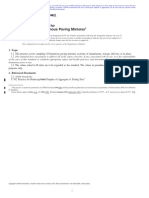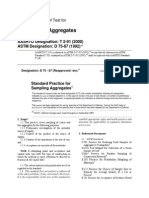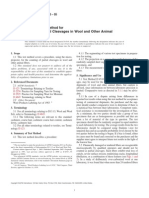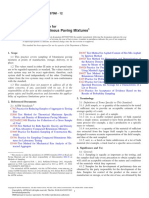SOP For Sampling On Paver
SOP For Sampling On Paver
Uploaded by
malique ayetCopyright:
Available Formats
SOP For Sampling On Paver
SOP For Sampling On Paver
Uploaded by
malique ayetOriginal Description:
Original Title
Copyright
Available Formats
Share this document
Did you find this document useful?
Is this content inappropriate?
Copyright:
Available Formats
SOP For Sampling On Paver
SOP For Sampling On Paver
Uploaded by
malique ayetCopyright:
Available Formats
STP 103
Standard Test Section: SAMPLING
Procedures Manual Subject: SAMPLING ASPHALT MIXES
1. SCOPE
1.1. Description of Test
These methods cover sampling of bituminous paving mixes at the points of manufacture,
storage or delivery.
2. APPARATUS AND MATERIALS
2.1. Number of Samples
The number of samples to be obtained by one of the methods described below depends on
the criticality and variability of the property to be measured. The number of samples
should be sufficient to provide the desired confidence in test results.
Unless otherwise specified, sampling frequency shall be:
For routine production control, take one sample for every 3 hours of plant operation.
For check testing of field laboratory results, submit samples to district or central
laboratories as described in STP 101.
Sampling intervals or locations should be selected by a random method and should be
clearly designated before samples are selected.
3. PROCEDURE
3.1. Sampling
3.1.1. Sampling From Conveyor Belt
Stop the conveyor belt carrying bituminous mix and insert the templates which
conform to the shape of the belt.
Space the templates so that the material contained between them will yield a
sample of the required weight shown in Table I.
Carefully scoop all materials between the templates into a suitable container.
Date: 1993 03 22 Page 1 of 4
Standard Test Procedures Manual STP 103
Section: Subject:
SAMPLING SAMPLING ASPHALT MIXES
3.1.2. Sampling From Paver
Stop the paver carrying bituminous mix and scoop the bituminous material into a
suitable container. Scoop enough material so that the sample can be split into two
2500 gram samples. Samples can be obtained from the paver at designated lots.
Sampling from the paver is primarily used to obtain samples for Abson testing.
3.1.3. Sampling From Truck Transports
Select the truck unit to be sampled by a random method.
Obtain at least three approximately equal increments selected at random from the
unit being sampled and combine to form a field sample of the quantity shown in
Table I.
The increments may be obtained by placing containers in the transport at the
appropriate time to catch the increments with a scoop or shovel.
3.1.4. Sampling From Roadway Prior to Compaction
Select the areas to be sampled from the material in place, by a random method.
Clearly mark the specific areas from which each increment is to be removed.
Templates placed before the mixture is spread will be a definite aid in securing
approximate increment weights.
Obtain at least three approximately equal increments selected at random from the
area being sampled and combine to form a field sample of the quantity shown in
Table I.
Take all increments from the roadway for the full depth of the material, taking care
to exclude any underlying material.
Page: 2 of 4 Date: 1993 03 22
Standard Test Procedures Manual STP 103
Section: Subject:
SAMPLING SAMPLING ASPHALT MIXES
TABLE I: GUIDE FOR SAMPLE SIZE
Maximum Nominal Approximate Weight Approximate Area
Size of Aggregate Of Uncompacted of In-Place
Mixture (kg) Mixture (cm2)
2.00 mm 2 250
4.00 mm 2 250
9.00 mm 4 250
12.50 mm 5 500
18.00 mm 7 700
25.00 mm 10 1000
40.00 mm 12 1000
50.00 mm 20 1500
3.1.5. Sampling From Roadway After Compaction
Samples shall be collected in accordance with STP 204-5, ASPHALT
CONCRETE SAMPLES OBTAINED BY CORING.
3.2. Shipping
Transport samples in containers so constructed as to prevent loss or contamination to any
part of the sample during shipment.
Samples shall have individual identification attached giving the information required by
the sample user. Typical information for plant mixed samples should include field test
results such as contract number, pit file, data, stockpile number, sample number, control
section, date sampled and any other pertinent information.
Samples taken from roadway should include such information as station number and
transverse location in pavement, also whether sampled from completed pavement or
windrow, quantity represented, date, tests required, and by whom submitted, etc.
Date: 1993 03 22 Page: 3 of 4
Standard Test Procedures Manual STP 103
Section: Subject:
SAMPLING SAMPLING ASPHALT MIXES
4. ADDITIONAL INFORMATION
4.1. General Sampling
Sampling is equally important as the testing and the sampler must take every precaution to
obtain samples that will yield an acceptable estimate of the nature and conditions of the
materials which they represent.
Samples for control testing and development of preliminary data are obtained by the lab
person or plant inspector.
The materials shall be inspected to determine discernible variations and the contractor will
provide necessary equipment needed for safe inspection and sampling.
4.2. References
ASTM D979
Page: 4 of 4 Date: 1993 03 22
Standard Test Procedures Manual STP 103
Section: Subject:
SAMPLING SAMPLING ASPHALT MIXES
APPROVAL SHEET
New Revision X Date of Previous Document 92-07-25
Effective Date: 93-03-26
Description of Revision (Reason for Revision):
- Procedure for sampling from paver has been added. This procedure was
added for samples taken for Abson testing.
Review/Implementation Process:
- Reviewed by the Lab Supervisors Committee and End Product Specification
Committee.
Other Manuals/Policies Affected:
Nil
Follow Up/Training Required:
Nil
Comments/Concerns/Implications (Budget/Environment/Stakeholders):
Prepared and Recommended by D. MacLeod 93-03-22
Quality Control Engineer Date
Approval Recommended by R.A. Widger 93-03-24
Senior Materials Engineer Date
Approval Recommended by A.R. Gerbrandt 93-03-24
Dir., Technical Standards & Policies Br. Date
Approved by D.G. Metz 93-03-26
Assistant Deputy Minister, Infrastructure Date
Electronic File Updated 93-04-28
Update Mailed - -
Date: 1993 03 22 Page: 5 of 4
You might also like
- BellaHelena Boutique Hotel & Spa Business PlanDocument31 pagesBellaHelena Boutique Hotel & Spa Business Planmasroor80% (5)
- JIS M 8109-1996 Method For Sampling and Method of Determination of Moisture Content of Garnierite Nickel OreDocument30 pagesJIS M 8109-1996 Method For Sampling and Method of Determination of Moisture Content of Garnierite Nickel OreAnjani Prastika100% (6)
- Reg CC Funds Availability ChartDocument1 pageReg CC Funds Availability Chartslade1je100% (1)
- ASTM D6307.2019 Determination of Asphalt Content by Ignition MethodDocument5 pagesASTM D6307.2019 Determination of Asphalt Content by Ignition Methodjitendra100% (1)
- Random Sampling of Construction Materials: Standard Practice ForDocument13 pagesRandom Sampling of Construction Materials: Standard Practice ForaraNo ratings yet
- Technical Methods For Highways Sampling Methods For Roads Construction MaterialsDocument59 pagesTechnical Methods For Highways Sampling Methods For Roads Construction MaterialsPatrick Bauman100% (1)
- Sampling Bituminous Paving Mixtures: Standard Practice ForDocument4 pagesSampling Bituminous Paving Mixtures: Standard Practice ForAnonymous x7VY8VF7No ratings yet
- Experiment #3 Sieve AnalysisDocument3 pagesExperiment #3 Sieve AnalysisChristelle KharratNo ratings yet
- Astm D 1335 - 03Document4 pagesAstm D 1335 - 03Liu SilverNo ratings yet
- Student Exploration Building DNADocument5 pagesStudent Exploration Building DNASidemen For Life0% (1)
- Soils Aggregates (Manual)Document72 pagesSoils Aggregates (Manual)DWIGHT GERONIMONo ratings yet
- Soil and Soil AggregatesDocument48 pagesSoil and Soil Aggregatesalvinsalingbay155No ratings yet
- D 979 - 96 Rdk3os1sruqDocument4 pagesD 979 - 96 Rdk3os1sruqel kevinsio el kevinsoNo ratings yet
- Highways Department: Guidance Notes Bulk Sampling of Bituminous MaterialsDocument8 pagesHighways Department: Guidance Notes Bulk Sampling of Bituminous Materialsdickliu dickliuNo ratings yet
- Sampling Materials For ShotcreteDocument2 pagesSampling Materials For ShotcreteEvert RiveraNo ratings yet
- AASHTODocument6 pagesAASHTOAngelica Fontamillas SuicoNo ratings yet
- Sampling Bituminous Paving Mixtures: Standard Practice ForDocument3 pagesSampling Bituminous Paving Mixtures: Standard Practice Forcesar gamezNo ratings yet
- ASTM D 3665 Random Sampling of Construction MaterialsDocument5 pagesASTM D 3665 Random Sampling of Construction Materialsiel84749No ratings yet
- AASHTO R90-18- Sampling Aggregate Products-081419Document4 pagesAASHTO R90-18- Sampling Aggregate Products-081419Ablelom2005No ratings yet
- Scan-Cm 41 - PfiDocument3 pagesScan-Cm 41 - PfiFrederico Manfio dos SantosNo ratings yet
- Laboratory Experiments Compilation: College of Engineering EducationDocument21 pagesLaboratory Experiments Compilation: College of Engineering EducationhachimanNo ratings yet
- AASHTO R60-12 (2020) - Sampling Freshly Mixed ConcreteDocument5 pagesAASHTO R60-12 (2020) - Sampling Freshly Mixed ConcreteErnesto Oscar VidelaNo ratings yet
- Astm D 3665 - 2002Document14 pagesAstm D 3665 - 2002pedroNo ratings yet
- Random Sampling of Construction Materials: Standard Practice ForDocument13 pagesRandom Sampling of Construction Materials: Standard Practice ForRed RedNo ratings yet
- Highways Department: Guidance Notes Bulk Sampling of Bituminous MaterialsDocument8 pagesHighways Department: Guidance Notes Bulk Sampling of Bituminous MaterialsCheung DavidNo ratings yet
- 1. AASHTO R60-12 (2020) Standard Practice for Sampling Freshly Mixed ConcreteDocument5 pages1. AASHTO R60-12 (2020) Standard Practice for Sampling Freshly Mixed ConcreteOscar NoelNo ratings yet
- D3665-12 2017 Random Sampling of Construction MaterialsDocument13 pagesD3665-12 2017 Random Sampling of Construction MaterialsWassim FekiNo ratings yet
- Astm D979D979M-15Document4 pagesAstm D979D979M-15mahdi sardarNo ratings yet
- AASHTO Fatigue-Flexural TestDocument12 pagesAASHTO Fatigue-Flexural TestTamanna KabirNo ratings yet
- Astm D979-22Document4 pagesAstm D979-22roberto139No ratings yet
- E300 PDFDocument24 pagesE300 PDFjfhl_12No ratings yet
- D979.28857-11 (1) Sampling Bituminous Paving MixturesDocument3 pagesD979.28857-11 (1) Sampling Bituminous Paving MixturesROBERTO MIRANDANo ratings yet
- Sampling of Aggregates Fop For Aashto T 2Document230 pagesSampling of Aggregates Fop For Aashto T 2mjfprgcNo ratings yet
- 04 Aashto PDFDocument296 pages04 Aashto PDFNada KhlifNo ratings yet
- Experiment: Marshall Method of Asphalt-Concrete Mix DesignDocument7 pagesExperiment: Marshall Method of Asphalt-Concrete Mix DesignWia AbdullahNo ratings yet
- Standard Test Procedures Manual: 1. Scope 1.1. Description of TestDocument6 pagesStandard Test Procedures Manual: 1. Scope 1.1. Description of Testthauwui86No ratings yet
- Sampling Freshly Mixed Concrete: Standard Practice ForDocument3 pagesSampling Freshly Mixed Concrete: Standard Practice Formoises19821986No ratings yet
- Asphalt Content of Asphalt Mixture by Ignition Method: Standard Test Method ForDocument5 pagesAsphalt Content of Asphalt Mixture by Ignition Method: Standard Test Method ForimgazaNo ratings yet
- I. General DiscussionDocument74 pagesI. General DiscussionAl ImranNo ratings yet
- D 559 - 96 Rdu1os1sruq - PDFDocument9 pagesD 559 - 96 Rdu1os1sruq - PDFLupita CarelyNo ratings yet
- Counting Partial Cleavages in Wool and Other Animal Fibers: Standard Test Method ForDocument7 pagesCounting Partial Cleavages in Wool and Other Animal Fibers: Standard Test Method ForSNEHANo ratings yet
- Astm D5444-15Document3 pagesAstm D5444-15UNUSED MUSIC MIRANDANo ratings yet
- ASTM C172 Sampling Freshly Mixed ConcreteDocument3 pagesASTM C172 Sampling Freshly Mixed ConcreteAdam JonesNo ratings yet
- College of Engineering Civil Engineering Program: Self-Instructional Manual (SIM) For Self-Directed Learning (SDL)Document5 pagesCollege of Engineering Civil Engineering Program: Self-Instructional Manual (SIM) For Self-Directed Learning (SDL)REX IAN BONGALESNo ratings yet
- Asphalt Ignition Test D6307Document5 pagesAsphalt Ignition Test D6307Anonymous oF1IiGAfNo ratings yet
- MTM0109 - Fertilizer Corrosion ResistanceDocument3 pagesMTM0109 - Fertilizer Corrosion Resistancedew88No ratings yet
- Sampling ProcedureDocument6 pagesSampling ProcedurearianamcazarinNo ratings yet
- Astm D2234 D2234M 16Document2 pagesAstm D2234 D2234M 16SamuelVamsi100% (1)
- C 233 Â " 00 QZIZMY1SRUQDocument6 pagesC 233 Â " 00 QZIZMY1SRUQJorge CarrascoNo ratings yet
- Sampling Bituminous Paving Mixtures: Standard Practice ForDocument3 pagesSampling Bituminous Paving Mixtures: Standard Practice Foraastha mehtaNo ratings yet
- ASTM D 6307 - 19 Standard Test Method For Asphalt Content of Asphalt Mixture by Ignition Method PDFDocument5 pagesASTM D 6307 - 19 Standard Test Method For Asphalt Content of Asphalt Mixture by Ignition Method PDFSAURABHNo ratings yet
- Astm D5444Document3 pagesAstm D5444karenmerino94100% (1)
- Sampling Aggregates: Standard Practice ForDocument5 pagesSampling Aggregates: Standard Practice ForPercyMinchanNo ratings yet
- Surveying- -Material-and-TestingDocument49 pagesSurveying- -Material-and-TestingJohn Ronald Rio FortuitoNo ratings yet
- Standard Methods of Sampling Stone, Gravel, Sand and Paving Mixtures For Use As Highway MaterialsDocument7 pagesStandard Methods of Sampling Stone, Gravel, Sand and Paving Mixtures For Use As Highway MaterialsWissem TaktakNo ratings yet
- D2234D2234M-10-Collection of Gross SampleDocument5 pagesD2234D2234M-10-Collection of Gross SamplechandramohanNo ratings yet
- Ce 435 Compilation of ExpirementDocument122 pagesCe 435 Compilation of ExpirementVeeNo ratings yet
- Mechanical Collection and Within-System Preparation of A Gross Sample of Coal From Moving StreamsDocument9 pagesMechanical Collection and Within-System Preparation of A Gross Sample of Coal From Moving StreamsEugene GudimaNo ratings yet
- Summary JIS M 8109 1996Document12 pagesSummary JIS M 8109 1996Bambang0% (1)
- BS 598-Part 101-87Document10 pagesBS 598-Part 101-87raju_civilengNo ratings yet
- Astm D 3665-12-17Document13 pagesAstm D 3665-12-17mohammed moid100% (1)
- Experiment No 1Document7 pagesExperiment No 1LJ IDANE ARANASNo ratings yet
- Exposure Assessment and Safety Considerations for Working with Engineered NanoparticlesFrom EverandExposure Assessment and Safety Considerations for Working with Engineered NanoparticlesNo ratings yet
- Aashto T316-13Document5 pagesAashto T316-13malique ayetNo ratings yet
- Correlation of Modulus Elasticity of Falling WeighDocument8 pagesCorrelation of Modulus Elasticity of Falling Weighmalique ayetNo ratings yet
- Manual of Practice FHWA US DOTDocument110 pagesManual of Practice FHWA US DOTmalique ayetNo ratings yet
- Sudarsono 2020 J. Phys. Conf. Ser. 1517 012030Document7 pagesSudarsono 2020 J. Phys. Conf. Ser. 1517 012030malique ayetNo ratings yet
- De Ections With A Falling-Weight-Type Impulse Load DeviceDocument3 pagesDe Ections With A Falling-Weight-Type Impulse Load Devicemalique ayet100% (1)
- Sealing and Filling Cracks in Asphalt Pavements: TechbriefDocument4 pagesSealing and Filling Cracks in Asphalt Pavements: Techbriefmalique ayetNo ratings yet
- 4.1.6 PL1662 Dynamic Cone Penetrometer (SPPLR)Document6 pages4.1.6 PL1662 Dynamic Cone Penetrometer (SPPLR)malique ayetNo ratings yet
- StandardsDocument2 pagesStandardsmalique ayetNo ratings yet
- 4.1.2 PL1658 Skid Resistance TestDocument4 pages4.1.2 PL1658 Skid Resistance Testmalique ayetNo ratings yet
- Comparison of Valuation of Skid Resistance of Pavements by Two Device With Standard MethodsDocument8 pagesComparison of Valuation of Skid Resistance of Pavements by Two Device With Standard Methodsmalique ayetNo ratings yet
- P. Starting Up: Log inDocument10 pagesP. Starting Up: Log inmalique ayetNo ratings yet
- Middle Ages History of PharmacyDocument15 pagesMiddle Ages History of PharmacyScribdTranslationsNo ratings yet
- Molecular Biology: Results & Unit Reference Value Test DescriptionDocument1 pageMolecular Biology: Results & Unit Reference Value Test DescriptionLibu GeorgebabuNo ratings yet
- Fire Safety Inspection Checklist: Department of The Interior and Local Government Bureau of Fire ProtectionDocument2 pagesFire Safety Inspection Checklist: Department of The Interior and Local Government Bureau of Fire ProtectionKilluaNo ratings yet
- World Pipe 2003Document4 pagesWorld Pipe 2003MostafaRockNo ratings yet
- Lab Techniques in MiceDocument53 pagesLab Techniques in MiceSilverEva4No ratings yet
- Reading 5Document79 pagesReading 5dangnganha159100% (2)
- Language Abilities in Bilingual Children With Autism PDFDocument213 pagesLanguage Abilities in Bilingual Children With Autism PDFSil TeixeiraNo ratings yet
- Autodata Training Course GuideDocument25 pagesAutodata Training Course GuideWaqar AliNo ratings yet
- Pharmaceutical Dosage Form Lab Prep 6-18Document7 pagesPharmaceutical Dosage Form Lab Prep 6-18Jana EncaboNo ratings yet
- BF 01780980Document14 pagesBF 01780980sena4kulaks4zNo ratings yet
- Gulf Synthetic Gear Oil - PAGDocument1 pageGulf Synthetic Gear Oil - PAGatripathi2009No ratings yet
- HACCP CertificationDocument5 pagesHACCP CertificationBabu LalNo ratings yet
- T16 English Operator ManualDocument64 pagesT16 English Operator ManualUmar ShamsudinNo ratings yet
- Reviewer in Infant and ToddlerDocument12 pagesReviewer in Infant and ToddlerLovely SollerNo ratings yet
- Motivation Theories On The Devil Wears PradaDocument26 pagesMotivation Theories On The Devil Wears Pradanurhafizatul asmakNo ratings yet
- Marketing of Ecofriendly and Low Cost Sanitary Napkins A Literature Review December 2021 0046515237 7608843Document4 pagesMarketing of Ecofriendly and Low Cost Sanitary Napkins A Literature Review December 2021 0046515237 7608843Samridhi SinghalNo ratings yet
- Computer-Based Technologies in Dentistry: Types and ApplicationsDocument8 pagesComputer-Based Technologies in Dentistry: Types and ApplicationsJaime Moncayo PinosNo ratings yet
- Investing in Infrastructure: Are Insurers Ready To Fill The Funding Gap?Document16 pagesInvesting in Infrastructure: Are Insurers Ready To Fill The Funding Gap?api-228714775No ratings yet
- Equ24-02 Chem Intergra400plus Op-SOPDocument12 pagesEqu24-02 Chem Intergra400plus Op-SOPDawoodNo ratings yet
- Material Used in Ship BuildingDocument13 pagesMaterial Used in Ship BuildingSayantan MondalNo ratings yet
- UM8717 - 2740-2745 Digitizers User Manual Rev6Document60 pagesUM8717 - 2740-2745 Digitizers User Manual Rev6ernestoNo ratings yet
- Waterex ThickenersDocument2 pagesWaterex ThickenerssaravananNo ratings yet
- Final Binder TechDocument546 pagesFinal Binder TechSubhankar DasNo ratings yet
- Chapter 9: Grading and Reporting SystemDocument14 pagesChapter 9: Grading and Reporting SystemSheejah SilorioNo ratings yet
- GOOD Example Assignment 1Document2 pagesGOOD Example Assignment 1Nor SyalwanisNo ratings yet
- 3.2 School Safety Assessment Tool (Detailed Indicators)Document18 pages3.2 School Safety Assessment Tool (Detailed Indicators)southccs SchoolNo ratings yet
- Polyethylene Glycol Standard - NAEnglishDocument12 pagesPolyethylene Glycol Standard - NAEnglishMikiNo ratings yet




































































































